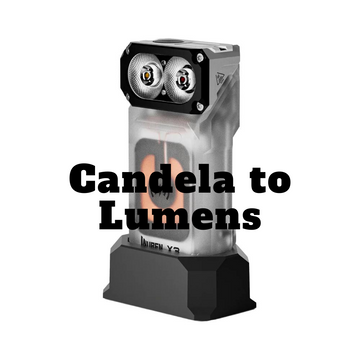Candela to Lumens: Understanding the Relationship and Its Impact on Lighting Design
Jun 04, 2023

What is Candela?
Definition and Importance of Candela
Candela, denoted as cd, measures luminous intensity—the amount of light emitted or reflected in a specific direction. It denotes the luminosity or brightness of a light source in a specific direction. As one of the seven base units of the International System of Units (SI), candela holds significant importance in physics and engineering. Photometers, which are specialized instruments designed to account for the human eye's sensitivity to various wavelengths of light, are employed for precise measurement of candela.What is Lumens?
Definition and Significance of Lumens
Lumens, symbolized as lm, quantify the total amount of visible light emitted by a light source in all directions. It represents luminous flux—the perceived power of light. Lumens provide a measure of the overall light output, regardless of its direction. This unit proves particularly useful when comparing the brightness of different light sources or determining the lighting requirements for a given space. Professionals rely on integrating spheres or other light measurement devices to obtain precise and reliable measurements of lumens.Conversion Formula: Candela to Lumens
Converting candela to lumens is a straightforward process that involves understanding the relationship between luminous intensity and luminous flux. The formula for this conversion is as follows:Lumens = Candela × Solid Angle
Here, the solid angle represents the portion of the complete sphere into which the light source emits light. It is measured in steradians (sr), a unit used to describe solid angles in three-dimensional space.
Importance of Candela to Lumens Conversion
Role in Lighting Design
Accurately converting between candela and lumens holds immense significance in various lighting applications. Lighting designers rely on this conversion to select the appropriate light sources for specific tasks or environments. The conversion enables designers to make informed decisions when choosing the appropriate lighting fixtures, considering the varying levels of illumination required for different settings. Whether designing lighting for workspaces, retail stores, or outdoor areas, the conversion from candela to lumens plays a pivotal role in achieving the desired lighting outcomes.Factors Affecting Candela to Lumens Conversion
Efficiency of Light Sources
The efficiency of the light source is a critical factor that affects the conversion from candela to lumens. Different types of light sources, such as incandescent bulbs, fluorescent lamps, or LEDs, have varying conversion efficiencies, impacting the overall light output and distribution. Understanding the efficiency of each light source helps designers make appropriate choices.Beam Angle and Distribution
The beam angle and light source distribution play a significant role in influencing the conversion process. A narrow beam angle may result in a different lumen output compared to a wider beam, affecting the lighting effects and coverage in a space. Consideration of the desired beam angle and distribution is essential to achieve the intended lighting outcomes.Tools and Resources for Candela to Lumens Conversion
Online Conversion Calculators
Converting between candela and lumens can be simplified with the help of online conversion calculators specifically designed for this purpose. These calculators take into account factors such as the beam angle and provide accurate results, allowing users to effortlessly obtain the corresponding lumen value for a given candela value.Specialized Light Measurement Devices
For more precise measurements, professionals rely on specialized light measurement devices like photometers or integrating spheres. These devices ensure accurate measurement of lumens and aid in obtaining precise lighting data for various applications.Reference Guides and Standards
Reference guides and standards provided by lighting organizations and institutes serve as valuable resources for understanding the conversion process and associated considerations. These resources offer detailed information and guidelines, enabling professionals to make informed decisions during the lighting design process.
Comprehending the interplay between candela and lumens is crucial in the realm of lighting design and measurement.
The conversion from candela to lumens equips designers with the knowledge needed to make educated choices, guaranteeing the selection of appropriate lighting fixtures that achieve optimal levels of illumination for diverse environments. By taking into account the factors that influence this conversion and leveraging the available tools and resources, professionals have the ability to craft meticulously engineered lighting solutions that cater to the specific demands of each application. Mastery of the art of candela to lumens conversion unveils boundless opportunities in lighting design, allowing us to fashion spaces that enthrall with their harmonious interplay of light.
Related Article:
What is Lumen
Lumens to Candela




